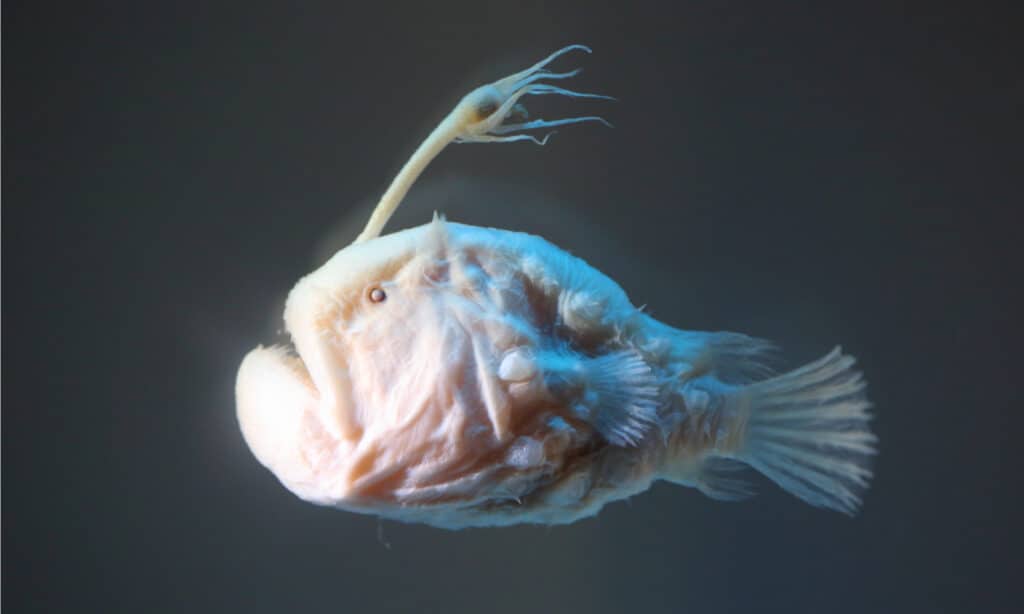Football Fish
The football fish is named after its unusual round or oblong shape
Advertisement
Football Fish Facts
- Prey
- Fish, crustaceans, and squid
- Group Behavior
- Solitary
- Fun Fact
- The football fish is named after its unusual round or oblong shape
- Estimated Population Size
- Unknown
- Biggest Threat
- Climate change
- Most Distinctive Feature
- The glowing lure on the female’s head
- Other Name(s)
- None
- Gestation Period
- Unknown
- Habitat
- Pacific, Atlantic, and Indian Oceans
- Predators
- Whales, sharks, and other football fish
- Diet
- Carnivore
- Type
- Ray-finned fish
- Common Name
- Football Fish
- Number Of Species
- 22
View all of the Football Fish images!
With its iconic glowing lure, the football fish is a large genus within the order of anglerfish.
Found within their isolated deep-sea habitat, these are shy and elusive fish. There are currently 22 recognized species. The sight of a live one is incredibly rare. It made international news when three of them washed up on the Pacific shore in 2021 alone. While there is still a lot about them we do not know, this article will cover some interesting facts about the size, appearance, and mating strategies of these deep-sea fish.
3 Incredible Football Fish Facts!
- The fishing rod is a modified fin at the top of the head known as the illicum. The soft bulb, also known as the esca, located at the end of the rod contains bioluminescent bacteria inside that enable it to glow in the dark of the deep sea. These bacteria enter the fish through small pores in the body.
- Football fish were first discovered around 1837 by the zoologist Johan Reinhardt.
- The football fish is one possible catch in the popular Nintendo Switch game “Animal Crossing: New Horizons.”
Football Fish Classification and Scientific Name
All 22 species of football fish belong to the genus Himantolophus. This scientific name comes from the combination of two Greek words: himantos, meaning leather strap or leash, and lopho, meaning crest or tuft. This refers to the thick leathery appearance of the rod on the top of the head. The football fish genus is the only currently living member of its family.
Football Fish Appearance
As the name suggests, the football fish possesses a large, round, or oval-shaped body that resembles a football. They also have very sharp teeth and black or brown scales. Like many types of anglerfish, the football fish has strong differences between females and males. The females measure up to 2 feet long and possess the large glowing angler rod that emerges from the head. They also have a covering of round, bony plates on their body. The males, on the other hand, measure less than 2 inches long and lack many of the same physical features as the female.

©feathercollector/Shutterstock.com
Football Fish vs. Angler Fish
The football fish is considered to be a type of anglerfish. The glowing rod at the top of the head is one major characteristic they share in common with other members of the anglerfish order. But there are some physical differences between the football fish and other types of anglerfish, including the shape.
Football Fish Distribution, Population, and Habitat
The football fish is primarily found in the deep tropical waters of the Atlantic, Indian, and Pacific Oceans. According to the IUCN Red List, most species are considered to be least concern or data deficient. Because of their deep-sea activity, it’s very difficult to make a proper estimate of population numbers. These fish have few threats in their natural habitat, but climate change could pose some problems in the future as the temperature of the oceans changes.
Football Fish Predators and Prey
Females typically sit and wait for prey to pass by. They lure the prey within distance of the mouth by using the glowing rod. Because of their poor swimming ability, they are thought to be mostly sedentary animals. Males typically do not eat very much once they reach maturity and must seek out a female to survive.
What eats the football fish?
Football fish predation has never been observed in the wild. Because of the depth in which it’s found, the football fish probably doesn’t have that many predators besides maybe some sharks and whales. One unfortunate football fish did end up as the stomach contents of a sperm whale. There are some indications that football fish of different species may consume each other as well.
What does the football fish eat?
The diet of the fish mostly consists of small fish, crustaceans, and squid. Because of the low density of food in the deep sea, they are not very picky about what they eat.
Football Fish Reproduction and Lifespan
Anglerfish have one of the most unique mating strategies of any animal in the world. As it grows, the male football fish will actually lose its digestive system. It must find a mate quickly or die. The female’s lure is thought to act as a source of attraction in the dark. When it has found a suitable mate, he will bite into her flesh and fuse with her body. The male will then lose most of its body -parts except for the testes to exchange sperm with the female. In return, the male will receive sustenance through the fusion of their blood vessels. It’s thought that the female can carry multiple around in this manner throughout its lifetime.
The evolution of this symbiotic mating strategy has been the subject of some debate. It’s been suggested that it evolved in response to the low density of fish in the deep sea. If the fish can attach to its mate and also reduce its own metabolic cost, then that improves overall fitness in such an inhospitable environment.
When the female has received the male’s sperm, she will produce a massive clutch of eggs and release them into the water. The larvae are free-swimming in the deeper parts of the ocean. Unfortunately, many facts about the lifespan and development of this fish have never been well recorded, but if it’s anything like the other types of anglerfish, then the lifespan of the female could last up to 30 years. The male, on the other hand, doesn’t survive very long as an independent entity once it has matured.
Football Fish in Fishing and Cooking
Because of their elusive deep-sea nature, live fish are not currently caught by fishers anywhere in the world. It isn’t known how edible they are, but they certainly do not have any value as food.
View all 91 animals that start with FFootball Fish FAQs (Frequently Asked Questions)
Where is football fish found?
The football fish are found throughout the deep sea of the Pacific, Atlantic, and Indian Oceans.
Why is it called a football fish?
It’s shaped like the ball used in football games.
How much is a football fish worth?
Real-life football fish do not have any real value on the market.
What does a football fish eat?
The football fish is thought to consume a mixture of fish, squid, and crustaceans.
Where can I catch a football fish?
The football fish lives so deep beneath the water that it is currently not possible to catch one. However, it is possible to catch a digital version of this fish in the popular Nintendo series “Animal Crossing.”
How do football fish reproduce?
They reproduce when the male fuses directly into the body of the female. This means the male basically exists to mate quickly and be absorbed by the female.
Thank you for reading! Have some feedback for us? Contact the AZ Animals editorial team.
Sources
- Ocean Conservancy / Accessed March 1, 2022
- All That's Interesting / Accessed March 1, 2022
- The Guardian / Accessed March 1, 2022


















